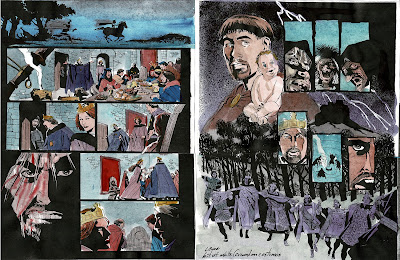When I was living in Kalamazoo, MI, my friend and neighbor Jim “The King” Wellington had a print hanging in his front room that always blew me away when I would see it. The picture had three women, one in black, one in red, and one in white, standing and looking at each other. It was rife with symbolism, infused with drama, and handled with a mastery of draftsmanship and painted in a classical style. While I never could get Jim to part with it, he was gracious enough to lend it to me for an extended period of time.
 |
| Two of the sisters from King Lear. and below, a closeup of Cordelia from the larger mural. |
These were pre-internet days and being fairly ignorant of illustrators and paintings, I had no idea that the artist was Edwin Austin Abbey and that the picture itself, a scene from Shakespeare’s King Lear featuring his three daughters, was quite famous. Before I returned the print to Jim, I do remember using one of the central figures as a character in the Sisterhood of Steel comic I was drawing at the time.
 |
| Twelfth Night |
 |
| McBeth |
 |
| Richard the Third |
 |
| Hamlet |
Ten years later when I was working on HBO’s Tales From the Crypt they were shooting at the Mount St. Mary’s University library. The room was dominated by three different mural forms Shakespearean plays. One look and I realized this was the same artist who’s work had stunned me a decade before. Fortunately, when I mentioned the work to my good friend Bill Stout, he immediately explained to me whose work this was.
 |
 |
| Two gentleman of Verona |
Working in the latter part of the nineteenth century, Abbey was famous for his intricate pen and ink drawings done for Harper’s. Full color reproduction was a luxury at best, so linework dominated the drawings done at the time. However, Abbey was also involved in designing sets and costumes for a number of Shakespeare’s plays as well as producing several large murals featuring literary subjects, and these are the source of most of the color work presented here.
 |
| Costume designs |
(The Abbey bio below is from Arpi Emoyan's excellent book on Hall of Fame Illustrators, Famous American Illustrators. A must for your book collection.)
Edwin Austin Abbey (1852-1911)
The brilliant draftsmanship of Edwin Austin Abbey's pen and ink drawings were perfectly suited to the reproduction techniques of the late 1800's. His genius as an artist was further established when he began working in other media as well- watercolor, oil, pastel- and swiftly mastered them all. 
 |
| Henry VI |
A major contributor to the "Golden Age of American Illustration". Abbey was held in high esteem by art establishments on both sides of the Atlantic. Living in England as an American expatriate, he became a full member of the Royal Academy, painted the coronation of King Edward VII at the King's request, but declined an offer of knighthood in order to retain his U.S. citizenship.
 |
| Hamlet |
Growing up in Philadelphia, Abbey attended the Pennsylvania Academy of Fine Arts and began illustrating books and magazines at the age of 16. At 19 he joined the staff at Harper's, concentrating on English scenes and Shakespearean works. A trip abroad in 1871 made him realize that England was a great source for authentic props, costumes, and backgrounds for his historical illustrations. He returned there seven years later to take up permanent residence.
Even his enormous murals for the Boston public library and the State Capitol in Harrisburg, Pennsylvania, were painted in England. The Capitol murals, for which he paid $25 per square foot, are now valued at well over a million dollars.
In 1889 Abbey married a socialite and at their summer home in Gloucestershire they entertained such notables as Charles Dana Gibson, Augustus St. Gaudens, Stanford White, Henry James, James McNeill Whistler, Mark Twain and Arthur Conan Doyle. John Singer Sargent, a close friend, often used Abbey's Chelsea lodge studio in London.
 |
| Arthurian legends |
Abbey died in London in 1911, leaving behind an unfinished mural and a large collection of exquisite pen-and-ink illustrations. Today the Yale University Art Gallery in New Haven maintains the worlds largest repository of Abbey's works.
For more on Abbey, you can check out the link to Wikipedia (https://en.wikipedia.org/wiki/Edwin_Austin_Abbey, or track down the volume Unfaded Pageant by Lucy Oakley at Amazon.com.

































